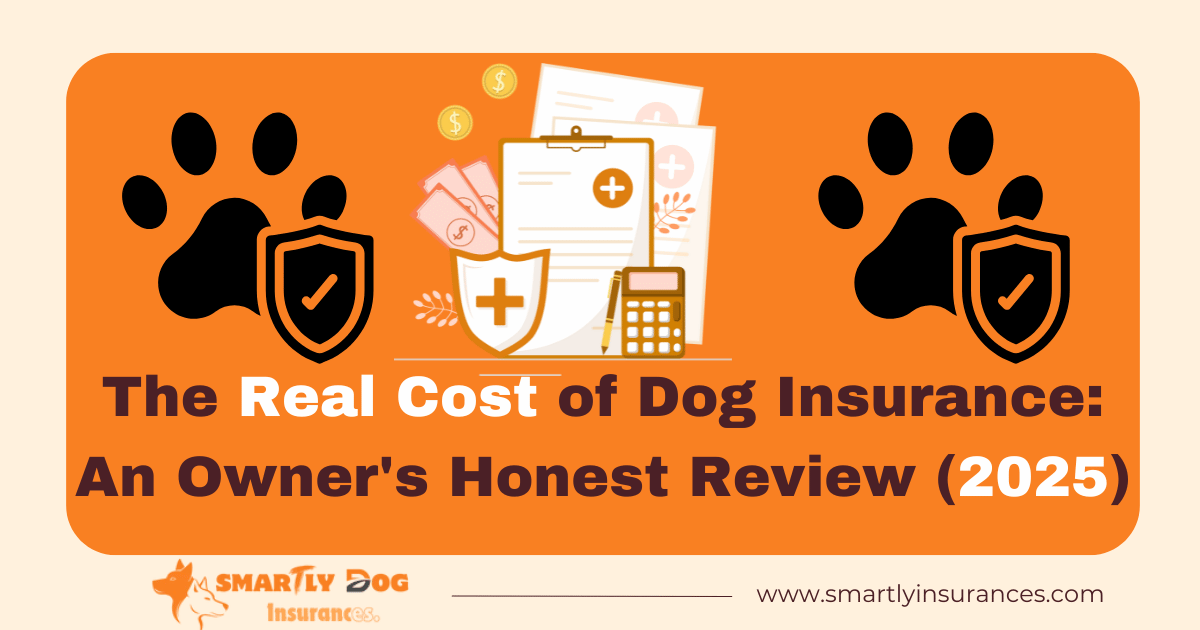One in three pets needs emergency veterinary care each year, and the costs can hit anywhere from $800 to $1,500 or more. The question of whether dog insurance is worth it became especially relevant to me after learning that six out of ten Americans don’t even have $1,000 saved up for emergencies.
Dog ownership costs about $1,391 yearly on average, but unexpected vet bills can really add up. Some procedures like ligament repairs might set you back $7,000. My experience as a dog owner has shown me both the advantages and disadvantages of pet insurance, which helps me understand what factors matter most.
Let me share my journey with dog insurance honestly. You’ll see the actual costs and savings from my experience, plus situations where insurance saved the day – and times it didn’t help much. We’ll get into real numbers, including monthly premiums between $19.93 and $48.66, so you can decide if pet insurance makes sense for your four-legged companion.
My First Year Costs with Dog Insurance
My research into dog insurance showed some eye-opening differences in monthly premiums among different breeds. Dachshunds cost the least to insure at $21 per month, right after mixed breeds. In stark comparison to this, French Bulldogs cost much more at $53 monthly. These differences come from each breed’s health risks and expected vet costs.
I chose a complete plan with an 80% reimbursement rate and a $250 deductible that first year. The monthly premium came to $38 for accident and illness coverage. Urban areas had higher premiums by a lot because vet costs tend to be steeper in cities.
My dog’s emergency surgery for swallowing a foreign object led to my first big claim. The bill hit $2,964, and once I met my deductible, insurance paid 80% of what was left. I ended up paying $593, while insurance covered $2,371.
I kept careful track of every vet bill that year. Insurance premiums added up to $456 for the year, plus the $250 deductible. All the same, just the emergency surgery alone helped me save about $1,778 in out-of-pocket costs.
One in three pets needs emergency treatment each year, which really puts things in perspective. To name just one example, treating hip dysplasia can run up to $7,815. This makes insurance extra valuable if you have breeds that often face these problems.
Breaking Down Insurance Costs by Dog Size
A dog’s size is a vital factor that determines insurance costs. I found significant differences in premiums between breeds of all sizes after looking at multiple insurance providers.
Small breed costs
Small breed owners pay lower insurance premiums. A simple accident and illness policy for smaller breeds costs between $30 and $71 monthly. Dogs like Shih-Tzus and Cocker Spaniels have lower rates because they don’t face expensive health problems as often. It also helps that medication costs stay low since dosages depend on the dog’s weight.
Large breed expenses
The story changes completely for large breed insurance costs. A dog over 40 pounds can cost up to $17,800 over its lifetime. Insurance providers charge more for larger breeds because:
- Their medications need larger doses, which drives up treatment costs
- They often develop bone, joint, and ligament problems
- Their size makes surgical procedures more complex and expensive
Your location affects these costs too. Urban areas with higher vet fees lead to bigger premiums. Many veterinary practices charge more for every service they provide to large-breed animals, from regular checkups to medical tests.
The cost difference becomes clear when you look at specific coverage options. A policy with $5,000 annual coverage and an 80% reimbursement rate costs $30-$40 monthly for small breeds, while larger breeds cost $52-$56. Then, a complete coverage plan with unlimited annual benefits ranges from $38-$44 for small breeds to $68-$69 for larger ones.
These price differences show the higher risk and cost of treating larger dogs. Insurance becomes especially valuable if you have a bigger breed since you might face larger vet bills throughout your pet’s life.
Hidden Fees and Charges to Watch For
Pet insurance policies hide a complex web of fees and charges that affect your costs. Smart decisions about coverage depend on understanding these hidden elements.
Deductible variations
Pet insurance deductibles work in two ways. Annual deductibles cost between $100 to $500, and you pay once yearly. Some policies use per-incident deductibles that require separate payments for each new health problem. Your monthly premiums drop with higher deductibles, but you’ll pay more from your pocket if your pet needs care.
Reimbursement rules
Insurance companies offer three reimbursement levels after you meet your deductible:
- 70% of covered costs
- 80% of covered costs
- 90% of covered costs
Companies calculate payments in different ways beyond the reimbursement percentage. Some take out the deductible first and then figure out reimbursement, while others do it the other way around. Your final payout could change by hundreds of dollars because of this difference.
Age-based premium increases
The biggest hidden cost comes from age-related premium increases. Insurance data shows premiums can jump between 155% to 1,162% as dogs age through their first twelve years. A mixed-breed puppy’s insurance might start at $68 monthly and reach $217 monthly by age twelve. This happens because older pets face more health risks.
Insurance for a 12-year-old mixed-breed dog can cost over $3,000 per year. Trupanion stands out by keeping steady premiums whatever the pet’s age, but they adjust rates based on vet care costs. Pet owners often feel surprised by these increases while planning long-term care costs.
When Dog Insurance Saved Me Money
My experience with dog insurance proved to be a great way to get insights when my pet faced unexpected medical emergencies.
Emergency surgery case
Without doubt, I saved the most money when my Dalmatian needed emergency surgery after swallowing plastic bottle caps. The total emergency bill reached $6,700. Thanks to my insurance plan with Embrace, I paid just a fraction of the cost. Like in my case, my friend’s Australian Cattle Dog needed CCL surgery that cost $3,000. The insurance reimbursement for this single procedure covered six years of premium payments.
Chronic condition management
We learned that pet insurance shows its true value in managing ongoing health issues. A 12-year-old dog’s case stands out – the pet was diagnosed with a rare spinal condition. The diagnostic tests alone cost $3,500. Insurance coverage made proper treatment possible and gave the dog three more healthy years.
Insurance helps manage expenses for chronic conditions that need consistent care. Common ongoing conditions include:
- Skin allergies (most frequent claim for all ages)
- Diabetes requiring regular medication
- Cancer treatments ranging from $3,000 to $10,000
- Endocrine disorders like Cushing’s disease
The right coverage makes managing these conditions affordable. To cite an instance, see a mast cell tumor removal that cost $4,270 with a reimbursement of $3,850. My dog developed aspiration pneumonia, and the $353 treatment cost dropped to just $318 out-of-pocket after insurance coverage.
Pet insurance proves its worth even more with serious conditions. Insurance covered 90% of an $8,000 snakebite treatment. A femoral head ostectomy procedure that cost $3,780 saw a reimbursement of $2,780. These real-life cases show how pet insurance protects your pet’s health and financial stability.
When Dog Insurance Wasn’t Worth It
My experience with wellness plans showed that standard pet insurance doesn’t cover simple veterinary care. Most policies won’t cover routine services unless you buy a separate wellness add-on.
Routine care coverage
A simple wellness coverage costs between $20 to $50 monthly. These plans sound great to start with and offer money back for services such as:
- Annual checkups and vaccines
- Flea and heartworm prevention
- Dental cleanings
- Blood work and screening tests
- Spay/neuter procedures
The numbers tell a different story. A simple wellness plan at $40 monthly adds up to $480 per year. After looking at my pet’s routine care needs, I spent only $350 yearly on preventive services, which made the wellness coverage a poor financial choice.
Wellness plan experience
My first year taught me that wellness plans have strict limits. Most plans set per-item caps – to cite an instance, they give back only $40 for vaccines or $50 for flea prevention yearly. This means you still pay the $15 difference when your vet charges $55 for an exam and your plan covers just $40.
Dental care turned out to be the biggest letdown. Many plans exclude common dental procedures like extractions, even though they advertise dental cleaning coverage. On top of that, some providers want full payment upfront and take weeks to pay you back.
Regular savings would have worked better than wellness coverage. Insurance works great for unexpected medical costs but falls nowhere near expectations for routine care. Setting aside $30-40 monthly in a dedicated pet care fund would have covered preventive services and let me choose care options freely.



